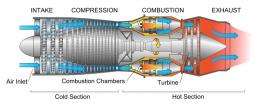High temperature, high speed metal fatigue test device with 1000C heat resistance

A research group led by Dr. Yoshiyuki Furuya, a Senior Researcher of the Materials Reliability Unit, National Institute for Materials Science, succeeded in the development of a high temperature ultrasonic fatigue test technology which is capable of evaluating the metal fatigue properties for critical components under high temperature, high frequency vibration environments which closely resemble the interior of jet engines and gas turbines.
A research group led by Dr. Yoshiyuki Furuya, a Senior Researcher of the Materials Reliability Unit, National Institute for Materials Science, succeeded in the development of a high temperature ultrasonic fatigue test technology which is capable of evaluating the metal fatigue properties for critical components under high temperature, high frequency vibration environments which closely resemble the interior of jet engines and gas turbines.
Turbine blades in jet engines and gas turbines are subject to resonance, which causes high speed vibration a frequency of several 1000Hz. In fatigue due to this vibration, the number of cycles exceeds 1 gigacycles (109, or 1 billion cycles). However, conventional fatigue tests are performed at a low frequency on the order of 10Hz (10 cycles per second, or 109 cycles in 3 years), and therefore require an extended test period. For this reason, evaluations of the fatigue properties of materials had been limited to around 107 cycles, which can be achieved in approximately 1 week.
In contrast, in this research, the NIMS Group conceived application of ultrasonic fatigue test technology, which is capable of realizing fatigue testing at a high frequency of 20,000Hz (20,000 cycles/second, achieving 109 cycles in 1 day) using ultrasonic vibration. Using this technology, the fatigue properties of materials can be evaluated rapidly up to the gigacycle region.
Because ultrasonic fatigue testing is a special test method using the phenomenon of resonance, the number of factors influenced by temperature is extremely large, and it was difficult to designate and make a device follow all these factors. To solve this problem, the NIMS group carried out a detailed analysis of the factors which are influenced by temperature, reviewed the control method, and added/improved part design and sensors. The team also discovered factors which had been overlooked in conventional research by a process which enhanced the completeness of the device while conducting trial-and-error experiments, and succeeded in correcting those problems. As a result, it was possible to develop a completely new device incorporating a large number of special improvements, based on a commercial testing device. The developed device can realize high accuracy ultrasonic fatigue tests at a high temperature of 1000°C, and thus is capable of performing fatigue testing under environments similar to the service environments of jet engines and gas turbines, which are exposed to high frequency vibration at high temperature.
In demonstration tests, the results of fatigue tests performed with the device developed in this research were in good agreement with the comparison data (fatigue test results accumulated over a long period of several decades), showing the high reliability of the test results with the developed device. The development of a high temperature ultrasonic fatigue test device enabling testing up to 1000°C and confirmation of the reliability of the test results will contribute to improved reliability in jet engines and gas turbines, and is also expected to accelerate research and development of materials for use in high strength turbine blades.
The results of this research were presented on July 18 at the M&M 2011 Materials and Mechanics Conference of the Japan Society of Mechanical Engineers.
Provided by National Institute for Materials Science















